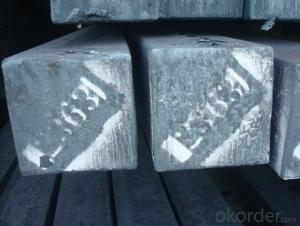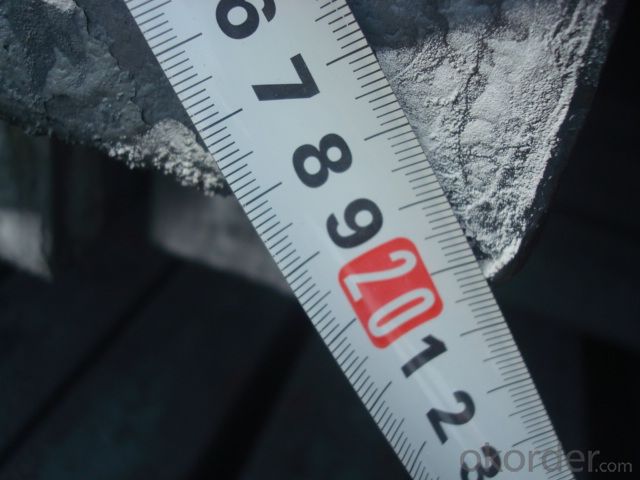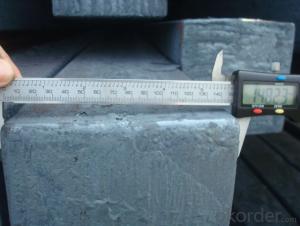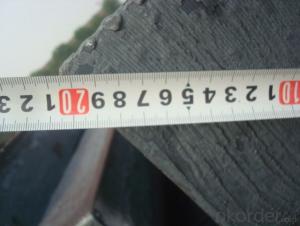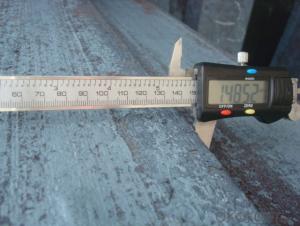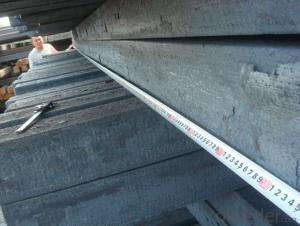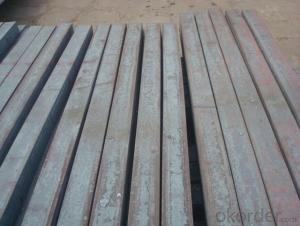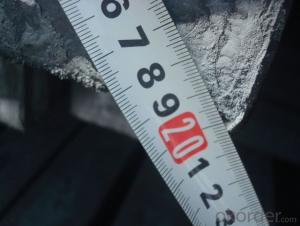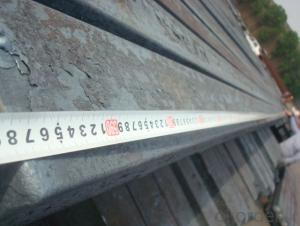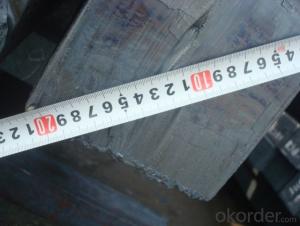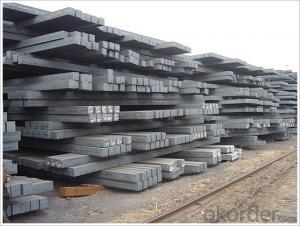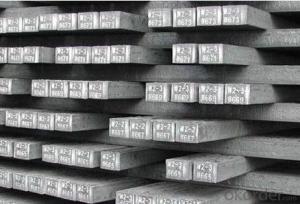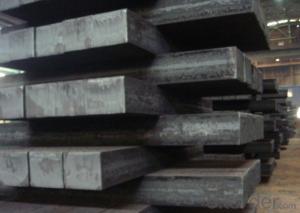Continue Casting Steel Billets/Blooms Produced by Blasting Furnace
- Loading Port:
- Tianjin
- Payment Terms:
- TT OR LC
- Min Order Qty:
- 1000 m.t.
- Supply Capability:
- 100000 m.t./month
OKorder Service Pledge
OKorder Financial Service
You Might Also Like
Continue Casting Steel Billets/Blooms Produced by Blasting Furnace
1.Structure of Continue Casting Steel Billets/Blooms Produced by Blasting Furnace
Continue Casting Steel Billets/Blooms Produced by Blasting Furnaceis the raw material of all kinds of steel mill. Billet section of square, round, flat, rectangular and abnormity, etc Several, mainly related to shape of rolled products. Simple rolled section steel, choose cross section of square billet or rectangular billet. rolling The sector products such as flat steel, Angle steel, select the rectangular billet or slab. Had better profiled billet when production beams, channels, and in rolling process Lines and improve the yield. The raw material of round billet is the production of seamless tube.
2.Main Features of Continue Casting Steel Billets/Blooms Produced by Blasting Furnace.
Continue Casting Steel Billets/Blooms Produced by Blasting Furnacesection size should meet the requirements of rolling deformation and finished product quality, but also roll strength and biting condition of restrictions. General steel Billet section height H. And the roll diameter D The ratio of the ( namely H/D) Should be less than or equal to zero 0.5 . Length of steel billet by finishing temperature, Rolling time and the length of the product Or times ruler. When heated too long accident prone to bump the furnace wall of steel, too short, furnace bottom utilization rate is not high, influence the heating furnace production. For the production Choose a variety of steel and steel billet, should consider the affinities of billet, as far as possible in order to improve the productivity of the roughing mill, simplify the stock management of workshop.
There are three shapes of the steel billets: square billet, slab, rectangular billet The Chinese billet, rectangular billet is mainly suitable for rolling hot rolled strip, building reinforced bar, Ordinary wire, high speed wire rod and various small profile. Of the slab are mainly used for rolling plate and hot coil sheet.
3. Continue Casting Steel Billets/Blooms Produced by Blasting Furnace Images


4. Continue Casting Steel Billets/Blooms Produced by Blasting Furnace Specification
Continue Casting Steel Billet by Blasting Furnace rolled steel, after processing can be used for mechanical parts, forging parts, processing all kinds of steel, steel Q345B channel steel, wire rod is the role of the billet. Steel billet is used in the production of semi- finished products, generally cannot be used directly for the society. Steel billets and steel are strictly divided into standard, cannot decide to whether the business enterprise of the final product, and according to unified standards to perform the whole society. Typically, billet and the steel is relatively easy to distinguish, but for some steel billet, and have the same specification and same steel purposes (such as rolling tube billet), whether can be used for other industries, whether through steel processing process, whether through a finished product rolling mill processing to distinguish
Material standard The editor Range of thickness: 150-240 - mm + / - 5 mm width range: 880-1530 - mm + / - 20 mm Length: 3700-10000 - mm + / - 500 - mm Cross-sectional size: 64 * 64; 82 * 82; 98 * 98; 124 * 124; 120 * 150; 152 * 164; 152 * 170 mm Length: 9000 mm Section of tolerance: billet: 1.0 + / - 2.0-1.0 + / - 1.0 mm slab: width: + / - 2.0 mm thickness: + / - 3.0 mm The length tolerance: + / - 200 mm Section diagonal tolerance: 3.5-8.0 MM Billet section size protrusions requirements: < 1242 mm, do not allow; > = 1242 mm, < = 2 mm 1242 mm, < = 3 mm Beheading (shear) extension deformation: < 1242 mm billet: no control; The slab: < = 15 mm Surface tilt: no more than billet section 0.1 Bending: every 1 m length is not more than 10 mm The distortion: length < = 5 m, < = 11. ; The length of the < = 7.5 M, < = 5. Material % 3 sp/PS chemical composition: C Mn Si S P
5.FAQ of Continue Casting Steel Billets/Blooms Produced by Blasting Furnace
We have organized several common questions for our clients,may help you sincerely:
①How about your company?
A world class manufacturer & supplier of castings forging in carbon steel and alloy steel,is one of the large-scale professional investment casting production bases in China,consisting of both casting foundry forging and machining factory. Annually more than 8000 tons Precision casting and forging parts are exported to markets in Europe,America and Japan. OEM casting and forging service available according to customer’s requirements.
②How to guarantee the quality of the products?
We have established the international advanced quality management system,every link from raw material to final product we have strict quality test;We resolutely put an end to unqualified products flowing into the market. At the same time, we will provide necessary follow-up service assurance.
③Could I know the process of the producing?
Sure.Steel billet is produced by the method of through three processes: It is through the steelmaking system of continuous casting equipment, directly by the molten steel pouring into billet; The second is the steelmaking system in the production of steel ingot casting billet through system of steel rolling rolling equipment or processing of steel semi-finished products; Three is the steelmaking system production of steel ingot by forging the semi-finished product processing equipment.How to distinguish between the size of the inclusions? The size of the inclusion size, it is according to the slab is processed into finished products, whether affect the processing performance and can be divided into two micro inclusions and large inclusions.It is generally believed that inclusion particle size less than 50 microns, called micro inclusions size greater than 50 microns large inclusions.The inclusions in the continuous casting billet come from? Found in the continuous casting billet of inclusion complex, forms.Judging from the inclusion of ingredients, can be roughly know the source of inclusions. (1) the weak deoxidizing elements contained in the inclusion is more, and SiO2 + MnO content greater than 60%, the size is more than 50 microns, which can determine the inclusions are caused by air and molten steel secondary oxidation; (2) inclusion composition and refractory materials, with special shape, size is larger, can determine for refractory erosion;(3) inclusion contains such elements as potassium, sodium, is due to mould protection slag in molten steel.
- Q: What are the factors that determine the lifespan of steel billets?
- The lifespan of steel billets is influenced by several factors. Firstly, the quality of the steel used in the production of billets is critical. Steel with high levels of impurities or inconsistent composition may have a shorter lifespan. The manufacturing process also plays a significant role. If the steel billets are not properly heated, cooled, or rolled, they may develop internal stresses or defects that can lead to premature failure. Environmental factors also impact the lifespan of steel billets. Exposure to corrosive substances, such as chemicals or moisture, can result in corrosion and degradation of the steel. Additionally, extreme temperatures can cause thermal expansion and contraction, leading to fatigue or cracking of the billets over time. The handling and storage of steel billets are also important factors. If they are mishandled, dropped, or subjected to excessive impact, it can lead to deformation or microstructural changes that reduce their lifespan. Proper storage conditions, including protection from moisture, direct sunlight, and extreme temperature fluctuations, can help preserve the integrity of the billets. Regular maintenance and inspection also contribute to determining the lifespan of steel billets. Timely detection and repair of any defects or damages can prevent further deterioration and extend their lifespan. In summary, the quality of the steel, manufacturing process, environmental conditions, handling and storage practices, as well as maintenance and inspections, all play crucial roles in determining the lifespan of steel billets.
- Q: How are steel billets measured?
- Steel billets are measured using various techniques and tools to ensure accurate dimensions and specifications. One common method is through the use of calipers or micrometers. These tools allow for precise measurements of the billet's diameter, length, and any other required dimensions. In addition to physical measurements, steel billets may also undergo non-destructive testing methods such as ultrasonic testing or eddy current testing. These techniques can detect any internal defects or inconsistencies in the billet, ensuring its quality and integrity. Furthermore, steel billets are often weighed to determine their mass. This can be done using different weighing scales or load cells, depending on the size and weight of the billet. The weight measurement is crucial in determining the billet's mass per unit length, which is important for calculating its density and other mechanical properties. Overall, the measurement of steel billets is a crucial step in the manufacturing process, as it ensures that the billets meet the required specifications for further processing and usage in various industries such as construction, automotive, and manufacturing.
- Q: How do steel billet prices fluctuate in the market?
- The market for steel billets experiences fluctuations in prices due to various factors. One of the primary factors is the demand and supply dynamics within the steel industry. When there is a high demand for steel billets, suppliers can increase prices as they have more leverage. Conversely, when there is low demand, suppliers may lower prices to compete for a smaller pool of buyers. The cost of raw materials is another significant factor impacting steel billet prices. Steel production relies on iron ore, coal, and scrap metal, and any changes in the prices of these materials directly affect the cost of producing steel billets. For instance, if there is a shortage of iron ore, the production costs rise, leading to an increase in the price of steel billets. Furthermore, market conditions and economic factors also influence steel billet prices. Inflation, interest rates, and currency exchange rates can affect the overall production and transportation costs, thereby influencing the prices of steel billets. Moreover, geopolitical events and trade policies can cause price fluctuations. Tariffs, trade disputes, or changes in import/export regulations can disrupt the supply chain, impacting the prices of steel billets. In conclusion, the prices of steel billets are influenced by a complex interplay of factors, including demand and supply dynamics, raw material costs, market conditions, and geopolitical events. Traders, manufacturers, and investors closely monitor these factors to predict and respond to price fluctuations in the steel billet market.
- Q: What are the main factors affecting the machinability of alloy steel billets?
- The main factors affecting the machinability of alloy steel billets include the composition of the alloy steel, the heat treatment it has undergone, the hardness of the material, the presence of impurities or inclusions, and the cutting parameters used during machining such as cutting speed, feed rate, and depth of cut.
- Q: 100Q235 steel can only be rolled from billets of Q235?Or a billet can be rolled into Q195~Q215 and other models of steel?Is there a detailed classification of billets? Do you have GB?
- The same type of steel, such as low carbon steel, the grade and composition design, but also look at the performance, therefore, a steel production process due to the abnormal quality, by the high grade and low grade sentenced to drop, but sales loss.......
- Q: How are steel billets used in the manufacturing of chemical processing equipment?
- The manufacturing process of chemical processing equipment heavily relies on steel billets. These billets act as the primary material that undergoes various transformations to become the final products necessary for chemical processing plants. To begin with, steel billets are crucial for the production of high-quality steel plates. These plates form the structural framework of chemical processing equipment. They are meticulously cut, shaped, and welded together to create vessels, reactors, and storage tanks. The exceptional strength and durability of steel make it the ideal choice for containing corrosive chemicals and withstanding the extreme pressures and temperatures experienced in chemical processing. Not only that, but steel billets also play a vital role in the creation of pipes and fittings used in chemical processing plants. These billets are heated and passed through a series of rollers to form seamless or welded pipes. The resulting pipes are then subjected to further processing and fabrication to meet specific requirements such as corrosion resistance, heat resistance, and pressure ratings. Additionally, steel billets are instrumental in the manufacturing of various components of chemical processing equipment, including valves, flanges, and other fittings. These components are essential for controlling the flow of chemicals, regulating pressure, and connecting different parts of the processing system. Steel billets are machined, forged, or cast to create these components, ensuring their strength, reliability, and resistance against chemical corrosion. To sum up, steel billets are an indispensable part of the manufacturing process for chemical processing equipment. Their versatility, strength, and resistance to corrosion make them the preferred choice for constructing the structural framework, pipes, and fittings needed in chemical processing plants. By utilizing steel billets, manufacturers can guarantee the reliability, safety, and longevity of the equipment used in the chemical industry.
- Q: Are steel billets used in the production of electrical transmission towers?
- Yes, steel billets are commonly used in the production of electrical transmission towers. Steel billets are the raw material that is used to manufacture various steel products, including transmission towers. These billets are heated and then shaped into the required sections and lengths to construct the tower structures.
- Q: How are steel billets used in the manufacturing of wire products?
- Wire products rely on steel billets as a crucial element in their production. These billets serve as the initial material for the wire manufacturing process. Typically, steel billets are semi-finished items that take the form of rectangular or square shapes. Molten steel is solidified to create these billets, which then undergo various shaping techniques to achieve the desired dimensions. The first step in using steel billets for wire production involves heating them to a specific temperature in a furnace. This procedure, known as annealing, serves to soften the steel and increase its malleability. Consequently, it becomes easier to mold the billets into wire shapes. Once the billets have been heated and softened, they are subjected to a series of rollers and drawing dies. These machines gradually decrease the cross-sectional area of the billets, elongating them into the desired wire diameter. Wire drawing is the term used to describe the process of reducing the billets' diameter. Throughout the wire drawing process, the steel billets undergo multiple passes through the rollers and drawing dies. Each pass further reduces the diameter of the billets until they reach the desired wire size. This continuous reduction in diameter also enhances the mechanical properties of the wire, such as tensile strength and ductility. Following the wire drawing process, the steel wire is typically wound onto spools or reels for additional processing or distribution. Depending on its intended use, the wire may undergo further treatments, such as heat treatment or surface coating, to enhance its properties or provide protection against corrosion. In conclusion, steel billets are utilized in wire product manufacturing through a series of steps involving heating, shaping, and drawing through rollers and dies to reduce their diameter and transform them into wire shapes. This process enables the production of wires with varying dimensions and properties, making them suitable for a wide array of applications in industries such as construction, automotive, electrical, and manufacturing.
- Q: How are steel billets used in the manufacturing of hydraulic components?
- Hydraulic components rely heavily on steel billets as a crucial raw material for their production. Billets, which are essentially semi-finished steel forms, are typically rectangular or square in shape. They undergo further processing to become various hydraulic components like cylinders, pistons, valves, and fittings. The manufacturing process begins by carefully selecting high-quality steel billets that meet specific mechanical and chemical requirements. These billets are then heated to a specific temperature, making them more malleable and easier to shape. Once heated, the billets undergo a series of mechanical processes such as forging, extrusion, or rolling to achieve the desired shape and size. For instance, in the production of hydraulic cylinders, the heated billets are usually forged or extruded to form the cylinder body. This involves applying high pressure to the billet, causing it to deform and take on a cylindrical shape. The resulting cylinder body is then further machined to precise tolerances to accommodate internal components like pistons, seals, and valves. Similarly, hydraulic valves and fittings are also manufactured using steel billets. The billets undergo various machining techniques such as turning, milling, drilling, and grinding to create intricate shapes and features required for these components. The final products are then subjected to heat treatment or surface treatment to enhance their strength, durability, and corrosion resistance. Steel billets are preferred in the manufacturing of hydraulic components due to their exceptional mechanical properties, including high strength, good ductility, and weldability. These properties ensure that the components can withstand the high pressures, extreme temperatures, and harsh operating conditions commonly experienced in hydraulic systems. In conclusion, steel billets play a vital role in the manufacturing process of hydraulic components. They undergo various mechanical processes to achieve the necessary shapes and sizes needed for cylinders, pistons, valves, and fittings. The use of steel billets guarantees the production of high-quality and reliable hydraulic components that can effectively function in demanding hydraulic systems.
- Q: How do steel billets contribute to the manufacturing of telecommunications devices?
- The manufacturing of telecommunications devices heavily relies on steel billets in several ways. Firstly, steel billets are utilized as raw materials for producing various components essential for telecommunications devices. These components comprise structural frames, housing, brackets, and mounts, among others. Steel's strength and durability make it an ideal choice for these parts as they must endure harsh environments and provide stability to the devices. Additionally, steel billets find extensive use in the production of transmission towers and antenna masts, which are crucial for efficient signal transmission and reception in the telecommunications industry. These towers and masts necessitate sturdiness and the ability to support heavy equipment to ensure uninterrupted communication. Steel, with its high strength and load-bearing capacity, is an optimal material for fulfilling these requirements. Moreover, steel billets are also employed in manufacturing cable trays and conduits, which are indispensable for organizing and safeguarding various cables used in telecommunications devices. These cable management systems guarantee proper routing and protection of cables from external factors like moisture, heat, and physical damage. Steel's resistance to corrosion and its ability to withstand extreme conditions make it an excellent choice for fulfilling these purposes. Apart from its physical properties, steel billets contribute to the manufacturing of telecommunications devices due to their cost-effectiveness. Steel is widely available and relatively inexpensive compared to other materials, making it a preferred choice for manufacturers. Its versatility and ease of fabrication further enhance the efficient production of telecommunications devices. In conclusion, steel billets play a vital role in the manufacturing of telecommunications devices by providing raw materials for various components, supporting infrastructure, and ensuring efficient cable management. Their strength, durability, cost-effectiveness, and availability make them an indispensable material in the telecommunications industry.
Send your message to us
Continue Casting Steel Billets/Blooms Produced by Blasting Furnace
- Loading Port:
- Tianjin
- Payment Terms:
- TT OR LC
- Min Order Qty:
- 1000 m.t.
- Supply Capability:
- 100000 m.t./month
OKorder Service Pledge
OKorder Financial Service
Similar products
Hot products
Hot Searches
Related keywords
